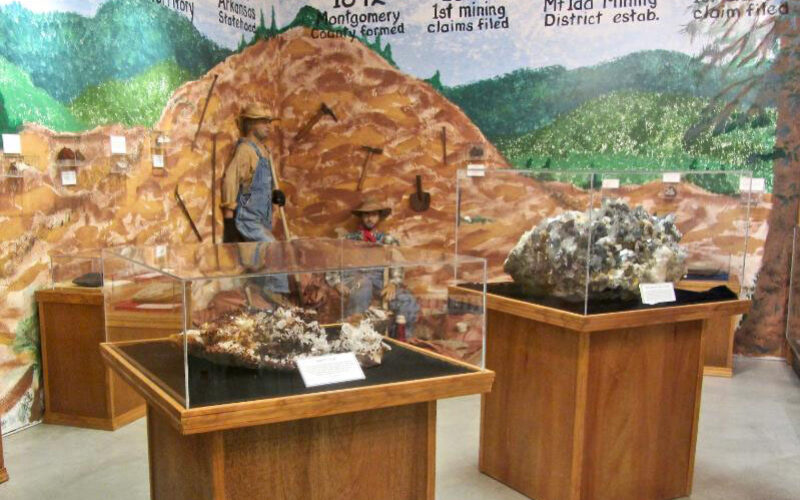JACK SCHNEDLER
Special to The Free Weekly
In and around Mount Ida, the identity of the official Arkansas State Mineral can be guessed just by looking around.
In fact (pun alert!), the laureate is crystal-clear from billboards and other signs. Since the General Assembly cast its vote in 1967, that honor has belonged to the quartz crystal.
Roadside shops near Mount Ida sell quartz in a spectrum of sizes, shapes and colors. Crystal specimens can be admired and bought at several mines, where visitors also may pay to dig for the minerals. The most actively promoted is Wegner Crystal Mines, located three miles south of Mount Ida, which proclaims itself “Quartz Crystal Capital of the World.”
In the town of 1,000, less than two hours southeast of Fort Smith, a helpful starting point is Heritage House Museum of Montgomery County. On display are visually striking examples of the mineral formations to be found in the Arkansas “quartz belt.” Thirty to 40 miles wide, it runs west through the Ouachita Mountains from Garland County into Oklahoma.
Quartz, as museum visitors learn, is composed of silicon and oxygen that becomes crystallized when heated by extremely hot water from underground sources. This reaction is believed to have happened in present-day Arkansas about 280 million to 245 million years ago as the Ouachita Mountains finished forming.
One prized museum specimen is the Blue Phantom Quartz Crystal. A sign explains that “this type of quartz is the result of an interruption in crystal development. A dusting of fine-grained black shale particles deposited on a growing crystal gives it a ‘phantom’ coloration as the crystal continues to develop, enclosing this darker mineral area. This extraordinary piece of crystal was dug by Frank Robins, founder of Robins Mining, during the early 1930s.”
Several nearby quartz mines welcome visitors. Wegner’s offers a bonus by displaying museum-quality pieces from Arkansas and around the world collected by proprietor Richard Wegner, a player in the global crystal market. He has amassed a collection of quartz, citrine, chrysanthemum stone and other minerals.
Among them is a phantom quartz cluster from his mines, in which the inside of each crystal displays outlines of many smaller crystals known as phantoms. From Brazil comes an orange-hued citrine geode, once known as as the Merchants Stone. The choicest of these beauties are valued at umpteen thousands of dollars, although locally mined examples begin at a few dollars a pound.
Visitors can dig for crystals to keep at some mines. Wegner’s operates tours daily to its Crystal Forest Mine, lasting two to three hours and costing $19. Its website asserts that “collecting at this mine is as easy as picking up the crystals exposed on the surface, especially after a good rain.”
Quartz crystals have value beyond their beauty. They have been used to make oscillators for radios, computer chips and clocks. They are an ingredient in synthetic stone materials used in kitchen countertops.
And, as noted in the Encyclopedia of Arkansas, “many people believe quartz contains metaphysical properties, and followers of the New Age movement look to crystals for their purported healing qualities and as an aid to altered levels of consciousness.”
Even naysayers who consider New Age to be old hat in 2023 can still be wowed by the best of the crystals to be seen at Wegner’s, as well as the museum in Mount Ida and other nearby mines. Quartz crystal, after all, has been the Natural State mineral for more than a half-century.
__
FAQ
Heritage House Museum
Of Montgomery County
WHEN — 11 a.m.-4 p.m. Tuesday-Friday, 1-4 p.m. Saturday-Sunday
WHERE — 819 Luzerne St., Mount Ida
COST — Free; donations welcome
INFO — mountidamuseum.org or 870-867-4422



